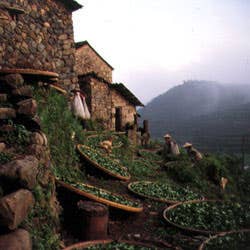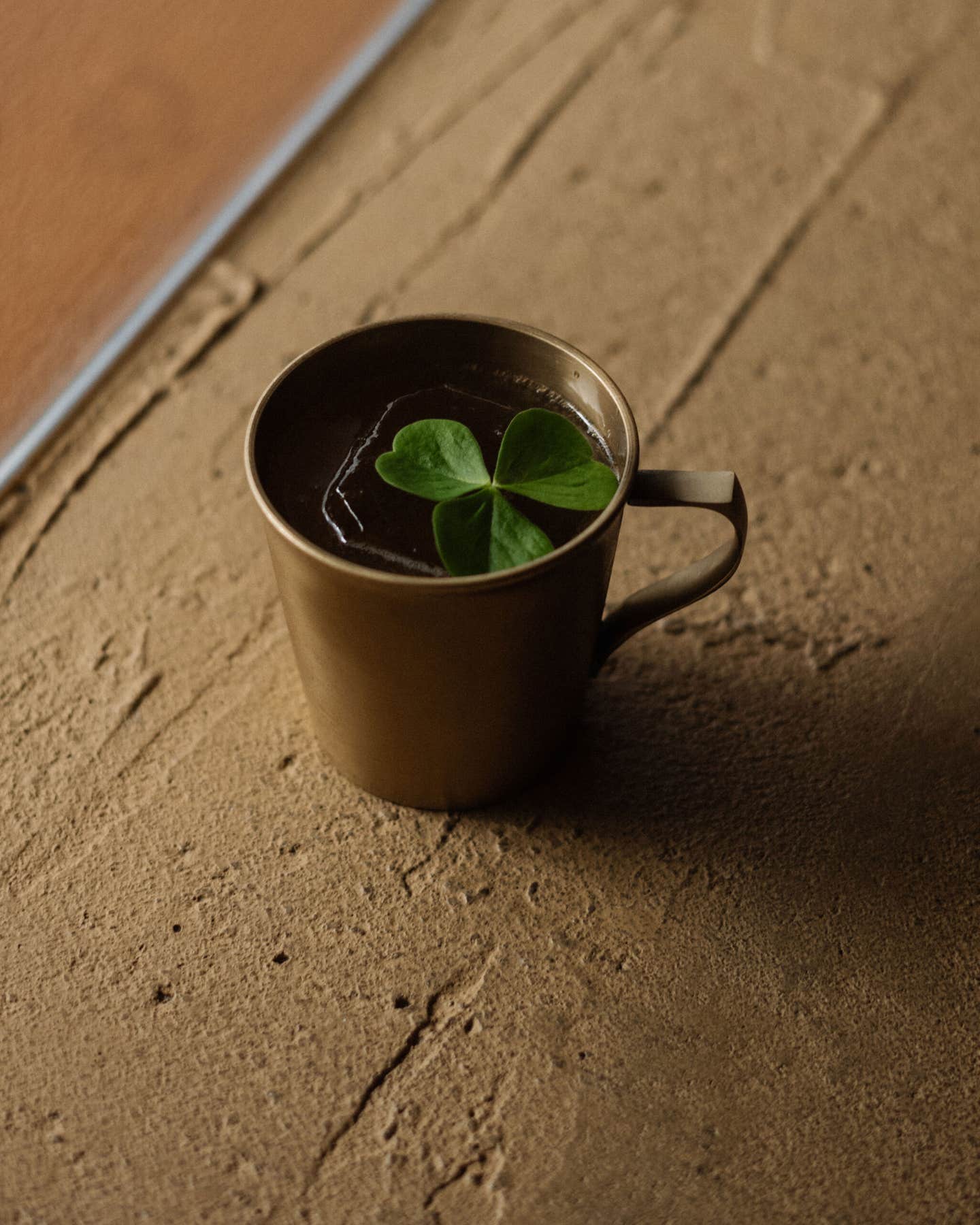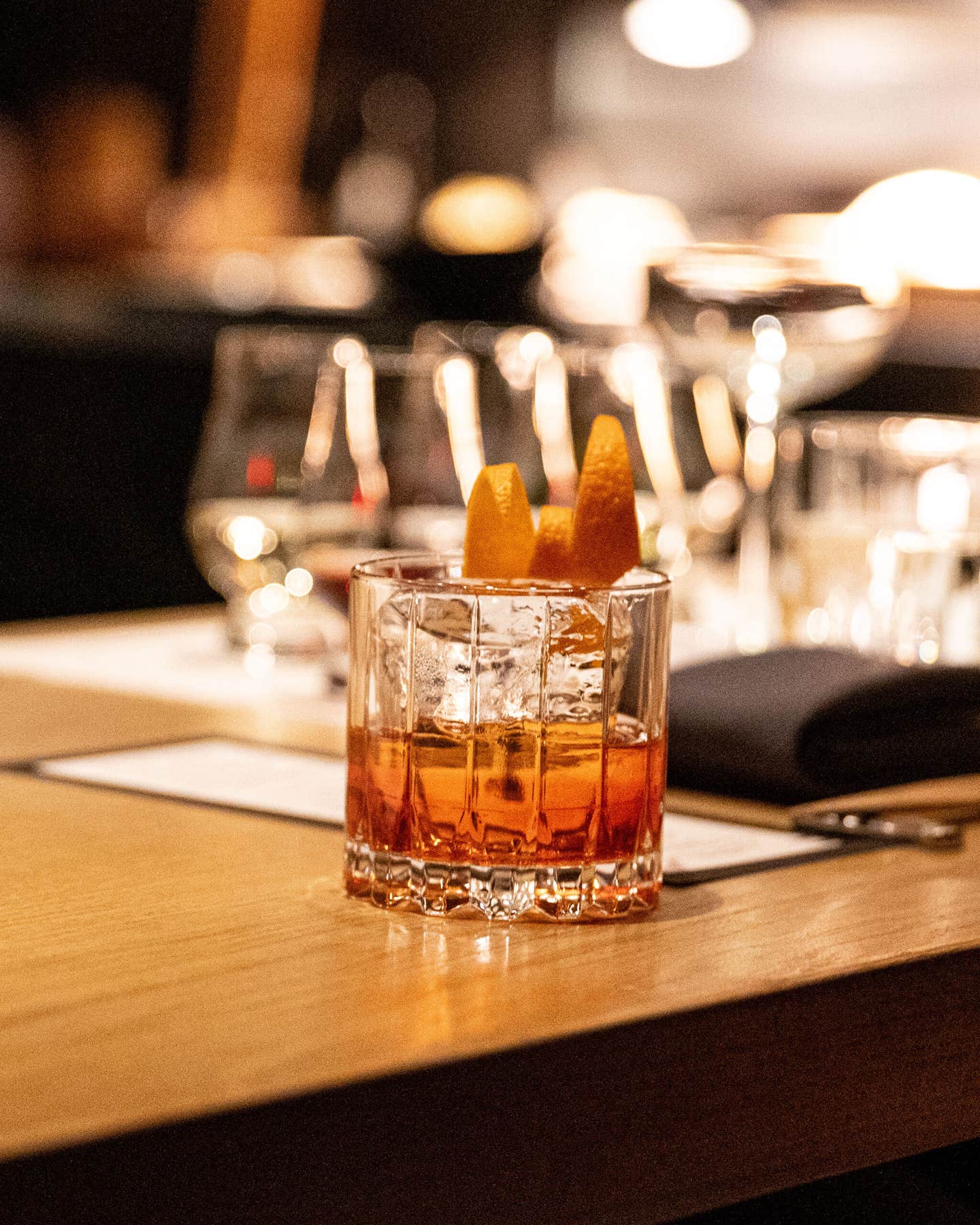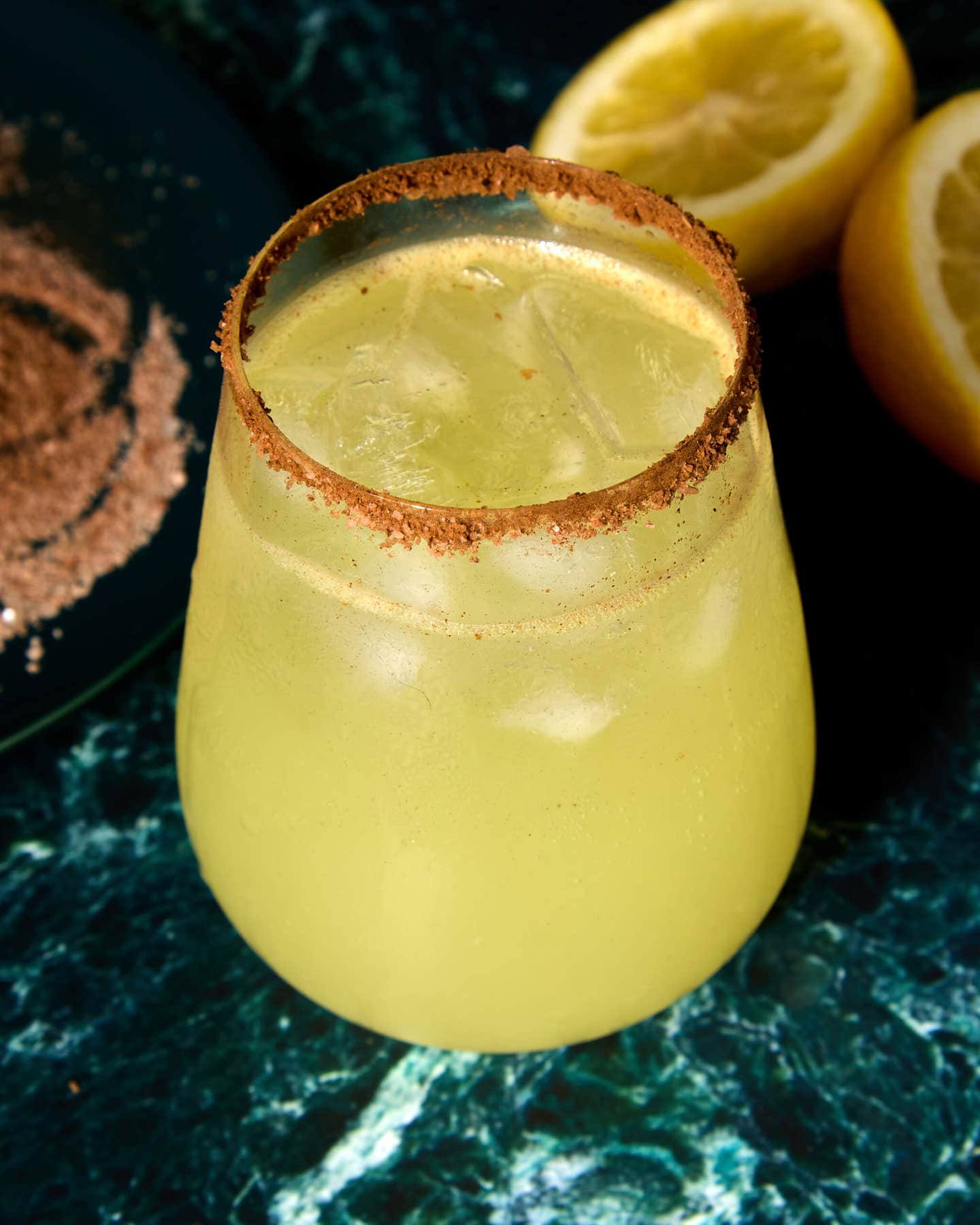
Making Tea
The minivan labors up a dirt road in the hills west of the Chinese port city of Xiamen, around hairpin turns, past stands of tall eucalyptus and tamarisk trees. Now and then, we come upon clusters of houses, with the delicate, curved, flaring roofs typical of Fujian province. It is late April, and the air is moist and pleasantly cool, the sky soft gray. Terraced paddies, vibrant with the luminescent light green shoots of young rice, cover the slopes above and below us. As we climb higher, these gradually give way to plantings of dry-field rice, then finally to fields of tea bushes, dense with shiny, dark green, almond-shaped leaves.
Arriving at the edge of a small village, we pile out of the van. There are five of us: my friend Ip Wing-chi, importer of Chinese teas into Hong Kong, and organizer of our expedition; Ip's tea master, Zhang Zhang-ping; Hong Kong cameraman George Chang, who is shooting footage for a video documentary Ip is making on tea culture; Sacramento grocer and wine merchant (and SAVEUR contributing editor) Darrell Corti, who wants to introduce fine Chinese tea to his customers in America; and myself.
It is raining lightly when we arrive, but along the road, men, women, and children ride or push bicycles loaded with big sacks of newly harvested tea. We walk in the rain for half an hour or so, along a side road. On the way, we pass a small tile-roofed shrine of fitted stone, and a gang of women picking tea in the drizzle, wearing the conical-shaped bamboo headgear that used to be called coolie hats. Across the valley from us, mist rises between, then above, the terraced pyramids of hills overlapping hills, all planted with tea bushes.
Finally, we reach our destination: the tea farm owned by Zhang-ping's older brother, Zhang Shui-lai—known as Big Zhang.
At the edge of the farm, a group of gray stone houses clings to the side of a hill. The newest and largest of these belongs to Big Zhang. The others belong to various cousins, each with their own adjacent tea farm. Many of the local villagers farm and/or process tea, too. But this is no longer a communal affair. In the 1980s, through a series of reforms, the Chinese government returned use of the land to the farmers. The government still holds title to the land itself, but individual farmers, like Big Zhang and his cousins, now own their own businesses and farm buildings, and may sell their produce to whomever they like. (Villagers who don't have their own farms buy newly picked tea from growers, then process and market it themselves.)
In fact, much of the tea grown here is sold to the government's National Export Corporation. Big Zhang, however, has made an unusual arrangement with Ip Wing-chi: The Hong Kong merchant pays him a flat rate for his entire harvest, regardless of volume and quality. Ip, in turn, sells the best of Big Zhang's teas in the five Lock Cha tea shops in Hong Kong of which he is part-owner, and at Hong Kong's Flagstaff House Museum of Tea Ware. The poorer grades are sold to the Chinese government and local stores.
Big Zhang leads us into his house and up a narrow wooden staircase. After dropping our bags in the rooms assigned to us (there seem to be about half-a-dozen bedrooms on the second floor, simply furnished), we gather for a taste of the first fruits of the spring harvest. In a gallery overlooking the central courtyard, we sit on stools and benches around a waist-high, square table of unfinished wood, worn smooth by years of heavy use. Everything is kept spotlessly clean, because tea readily absorbs extraneous odors.
Beyond the railing of the gallery, steep slopes stretch from a height of about 6,000 feet down to a stream and a small waterfall far below us, their water milky with the limestone residue that leaches out of the ground. Clouds drift through the valley, lit by the afternoon sun. The reddish earth—iron-oxide-rich friable granitic soil says Corti, who knows soil types from his wine studies—glows in the sun's rays. From the workshop on the ground floor, the scent of tea picked earlier in the day, now wilting and beginning to oxidize, reaches us in sweet, flowery draughts.
Big Zhang brings out a tray with two lidded brewing cups, or zhong, and many tiny porcelain tea cups. We sample two of the teas processed that day, first Huangjin Gui, or Golden Cassia, so named because its flavor resembles that of the cassia flowers (Osmanthus fragrans) used to flavor sweets in some parts of China. The golden-brown infusion has a light, floral fragrance, and a distinctive aftertaste resembling the flavor of the blossom for which it is named.
Then we sample Maohai, or Hairy Crab, the variety that forms the bulk of the harvest here. Hairy Crab takes its name both from the silky white hairs on the underside of the fresh leaves, and from, surprisingly, its perceptible crab-like flavor. It is lightly oxidized and complex, and in addition to that hint of crab (not fishy, not briny, but unmistakably reminiscent of that delicate seafood), it has a floral undertone and a sweet finish.
Both are superb and not quite like any tea I've had before—and, as I sip them, it occurs to me that this is the moment I have longed for since I first started drinking Chinese tea.
What most Americans think of as tea—broken, black bits of shriveled leaves in little paper sachets, trailing a Lipton's label at the end of a white string—is a world away from fine Chinese teas like those from Big Zhang's farm.
I've come to this corner of Anxi county in southern Fujian province because, after a long and satisfying acquaintance with Japanese tea, I have more recently begun to appreciate the teas of China—and because I wanted to see for myself how tea is harvested and processed here. This region, and indeed Fujian as a whole, is famous for tea—particularly for semifermented, or oolong, varieties. The process of making oolong, in fact, is sometimes said to have originated in this area.
The tea plant is believed by some authorities to be indigenous to Tibet and northern India as well as to China, but the Chinese take credit for drinking tea first—as much as 3,000 to 5,000 years ago, and possibly even earlier than that. Tea wasn't always brewed in lidded pots, however. The Chinese chewed tea leaves, boiled them in soup (in tea-producing regions of China today, there are still special banquets in which every dish is flavored with a different variety of tea), or compressed them into cakes, sometimes grinding them to a paste first. Tea was then made by breaking off pieces of the cake, crushing it to a powder, and whipping it with water. It was not until the 16th century that potters in the Yixing area, not far from Shanghai, invented the teapot—basing their design on a form of wine ewer—in which whole-leaf tea could be infused.
What we call black tea and the Chinese refer to as red tea seems to have been widely developed by the late 16th century, both for export to Europe and for trade with tribes at the extremities of the Chinese empire. The delicate green teas originally favored by the Chinese spoiled or rotted on long, damp sea voyages or on journeys across hot overland routes. Scenting teas with fresh flowers—a way of either enhancing a not very interesting tea or masking a stale or damaged one—also became popular around the same time.
Along with India, China produces much of the world's tea. Although all Chinese teas probably belong to the same genus and species, Camellia sinensis, these many varieties can differ greatly in both appearance and flavor. Some are suited to one type of processing, some to another.
Zhang's farm is small, yielding only about 8,000 catties of tea per year. (Chinese tea is measured in taels and catties. A tael equals 37.5 grams (or about 1.31 ounces); a catty is 16 taels—600 grams, or about 1.3 pounds—so Zhang produces not quite 10,500 pounds annually.) Women do the bulk of the harvesting on the farm, picking from 8 or 9 in the morning, after most of the dew has evaporated, until late afternoon. They use a small hand sickle, working from the top of each plant, carefully cutting one stalk at a time without slicing through the leaves. The leaves on the sides of the bushes are plucked by hand. (The precious Tie Guan Yin variety, harvested later in the spring, is picked entirely by hand.) The leaves are then dropped into plastic-coated fiber sacks.
When the pickers reach the broad, paved terrace that drops off precipitously in front of the workshop, they dump the tea leaves directly from the sacks onto the cement (or onto tarpaulins if there has been rain), spreading them thinly to wilt in the sun.
Big Zhang and Zhang-ping gently turn the leaves that have been spread on the terrace so that they wither evenly. Once they become soft and begin to give off a flowery fragrance, like that of irises—this generally takes several hours, though the time varies with the weather—the brothers pile them quickly into large baskets and carry them into the workshop, spilling them out on the clean-swept cement floor next to a large woven bamboo cylinder, rotated by a motor. Big Zhang loads the leaves into the cylinder a few armfuls at a time, allowing them to tumble for five minutes or so. This process, repeated two or three times for each load, bruises the edges of the leaves, releasing the enzyme that will oxidize, altering the chemical properties of the leaves and thus the color, fragrance, and flavor of the tea.
After bruising, the tea leaves are placed on bamboo trays about two feet in diameter, stacked floor to ceiling on wooden racks. The leaves are left to oxidize for no longer than a few hours. Then Big Zhang and the old man who seems to be his only full-time paid employee (aside from the pickers) build a fire, pushing split logs through a trapdoor in the bottom of a large kiln, in the center of which is a rotating stainless-steel drum. Judging when the leaves have reached the desired degree of oxidation by their fragrance, Big Zhang furiously tosses heaps of them into the turning drum.
Clouds of steam begin to escape as the leaves give up their moisture and the oxidation process is halted by the heat. (Until the 1960s, the first firing was done in much smaller quantities, in a wok over a wood fire. The Zhangs agree such hand-processing produced better tea—because the quantities handled are smaller and the handling itself gentler—but processing tea this way today would require more employees and be prohibitively expensive for Big Zhang.)
After ten minutes, Big Zhang pulls a leaf out of the still-rotating drum, rolls it between his fingers, and smells it. He reverses the direction of rotation, and the jade green leaves come gushing out. Smelling liked cooked greens at this point, the leaves are turned into a small rolling machine, rotated, then pressed for a couple of minutes to extrude still more moisture and to give the leaves their distinctive shape. Tossed back onto the bamboo trays like a salad, they are left to cool. The air is filled with a complex aroma of grassy chlorophyll and fruity oxidized tea.
Zhang Yin-peng, Big Zhang's young son, bears a considerable burden of responsibility for the latter stages of processing. He has little contact with anyone outside the farm or anything that does not have to do with making tea. Compared with teenagers here or in Hong Kong, he seems very innocent, humble, and shy.
The diligence and care that both he and his father display in every aspect of tea production are impressive—even to the ignorant visitor—and contrast sharply with what we see of tea processing in the village, or even at the hands of the other Zhang cousins. When I ask where this respectful attitude comes from, Big Zhang replies without hesitation, "From my father. He worked very hard to open up new land for tea cultivation, so it's our responsibility to carry on his work."
The Confucian virtue of filial piety is still very much alive here. To illustrate his father's sense of the fitness of things, he says, Big Zhang tells us the story of the teapot spout. The water used for making the tea we drink while we're on the farm is always heated in an electric kettle with a long, flaring spout. The original spout dribbled, says Big Zhang, so Old Man Zhang (his given name, Jia-xiang, means, appropriately, "increasing fragrance")—who died in 1989—cut it off and fashioned a new one out of tin, soldering it onto the kettle. Big Zhang tells the tale with genuine reverence.
The tea processing continues: When the leaves have cooled, Big Zhang wraps clumps of them, about the size of bowling balls, in big squares of cotton. Yin-peng carries these over to a long wooden bench, where he kneads each ball of tea first with his hands, then with his feet. This kneading extracts more moisture from the leaves, and also gives them their final shape—a factor that is surprisingly important in determining the flavor of the tea.
The balls are tossed back into the rolling machine, several at a time, for further mechanical kneading. Then each one is unwrapped and the tea inside it loosened. The balls are retied and the process is repeated, usually three times. Yin-peng takes charge of the next step as well: The balls of tea are unwrapped for the last time and the tea loosened and placed in hourglass-shaped bamboo baskets set over pits containing glowing coal bricks. This dries the leaves still further, and enhances their fragrance.
Patiently roasting the leaves, Yin-peng turns them so that they fire evenly. Next, he removes them from the heat and, after they cool, dumps them out into a sieve. Then the tea goes back into the baskets to be fired again. This process is repeated several times.
The entire operation should be finished the day the leaves are picked—and since the harvesting itself continues, in clear weather, late into the afternoon, the men often work till two or three in the morning, getting up the next morning to begin again. This relentless cycle continues for about a month, until all the spring teas have been picked and processed. (Tea is harvested from April through about November, though for green and oolong teas, the spring harvest is usually considered superior.)
The finished leaves should be glossy and even in color—a dark, brownish green. (Some semifermented teas are oxidized longer than others, turning darker, more brown than green.)
All the tea that is completely processed by tonight—about 30 catties of it—will be carried back to Hong Kong by Ip Wing-chi for immediate sale in the Lock Cha shops. The rest will be shipped to Hong Kong in a few weeks, where Zhang Zhang-ping will fire it again with charcoal to remove the moisture it will have absorbed during transport, as well as to enrich the flavor. The best quality of tea will be packaged unblended and sold in single-day harvest lots, although Ip is not sure his customers are ready for this new concept—single-day harvest tea—and may not label his teas as such.
Throughout our stay at Big Zhang's farm, Darrell Corti has been noticing parallels between tea and wine. "In processing both products," he says, "interventions by man are fairly simple. The production technology is very straightforward, using chemical changes found in nature—fermentation and oxidation." But it is on the level of connoisseurship that the similarities are most striking, he believes. "It seems to be more highly evolved in tea and wine than other kinds of beverages," he notes, "and the appreciation of both tea and wine rely very heavily on the sense of smell."
I keep this in mind on the afternoon of our last full day on the farm, when Zhang Zhang-ping prepares a tasting for us of four versions of Hairy Crab tea, each one harvested and processed on a different day. We all agree on the relative merits of the first and fourth teas. The dry leaves of #1 are tightly furled. After infusion, some have not softened or fully opened, and the liquor is bitter and lacking in fragrance. We learn that it has been harvested and processed on a rainy day.
After several infusions, the leaves of #4 are smooth and completely unfurled, with an even olive color edged with brown. They produce a tea with an intense, flowery fragrance and a delicate flavor. Picked and withered on a sunny day, it is clearly the finest of the four tasted. Sample #2, which has a loosely furled dry leaf, yields a sweet liquor with a pronounced crab-like flavor, but without much fragrance. And #3, whose dry leaves are also loosely furled, has aroma, but the liquor is not as smooth as that of either #2 or #4.
Later in the afternoon, we taste yet another Hairy Crab—the tea harvested and withered the day we arrived. It is less fragrant than #4, but has a more pronounced crab flavor, and a long, sweet finish. I prefer it to the more flowery #4, which our Hong Kong contingent judges will be most appealing to Hong Kong connoisseurs.
The five Hairy Crabs are destined to be treated as follows: #1, the rainy-day processed tea, that we found bitter, will be sold to the Chinese government; #2, flavorful but not so fragrant, will become the basic grade of Hairy Crab marketed by Lock Cha under its Fujian Oolong label; #3, whose aroma we found superior to its flavor, will be blended with a lower grade of Tie Guan Yin tea for some enhancement; #4, our favorite for fragrance and flavor, and the last Hairy Crab we tasted, will be set aside until the entire harvest is finished and compared with later harvests—after which one will be chosen as Lock Cha's top-grade Hairy Crab.
Keep Reading
Continue to Next Story










